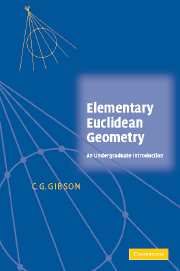Book contents
- Frontmatter
- Contents
- List of Figures
- List of Tables
- Preface
- Acknowledgements
- 1 Points and Lines
- 2 The Euclidean Plane
- 3 Circles
- 4 General Conics
- 5 Centres of General Conics
- 6 Degenerate Conics
- 7 Axes and Asymptotes
- 8 Focus and Directrix
- 9 Tangents and Normals
- 10 The Parabola
- 11 The Ellipse
- 12 The Hyperbola
- 13 Pole and Polar
- 14 Congruences
- 15 Classifying Conics
- 16 Distinguishing Conics
- 17 Uniqueness and Invariance
- Index
6 - Degenerate Conics
Published online by Cambridge University Press: 06 July 2010
- Frontmatter
- Contents
- List of Figures
- List of Tables
- Preface
- Acknowledgements
- 1 Points and Lines
- 2 The Euclidean Plane
- 3 Circles
- 4 General Conics
- 5 Centres of General Conics
- 6 Degenerate Conics
- 7 Axes and Asymptotes
- 8 Focus and Directrix
- 9 Tangents and Normals
- 10 The Parabola
- 11 The Ellipse
- 12 The Hyperbola
- 13 Pole and Polar
- 14 Congruences
- 15 Classifying Conics
- 16 Distinguishing Conics
- 17 Uniqueness and Invariance
- Index
Summary
The conics of greatest geometric significance are the non-degenerate ones, having a non-zero discriminant. Although the geometry of degenerate conics is uninteresting, they are not without significance as transitional types in families of conics. That is not the only justification for devoting space to degenerate conics. There are useful facts and techniques associated to them which are worth setting out properly. Section 6.1 introduces a particularly simple class of degenerate conics called binary quadratics, just one small step away from the familiar quadratics of school mathematics, and spells out the mechanics of handling them. That sets the scene for a more careful study of reducible conics in Section 6.2. The key facts are that reducible conics are automatically degenerate, and come close to being characterized by the sign of their delta invariant: moreover, there is an entirely practical procedure for finding the components of a reducible conic. By way of illustration we introduce pencils of conics, and ask how to find degenerate conics within the pencil, a question directly relevant to the focal constructions of Chapter 8. And in the final section we continue the theme by discussing the perpendicular bisectors of a real linepair, the simplest illustration of a central idea of the subject, namely the axes of a conic.
- Type
- Chapter
- Information
- Elementary Euclidean GeometryAn Introduction, pp. 54 - 64Publisher: Cambridge University PressPrint publication year: 2004



